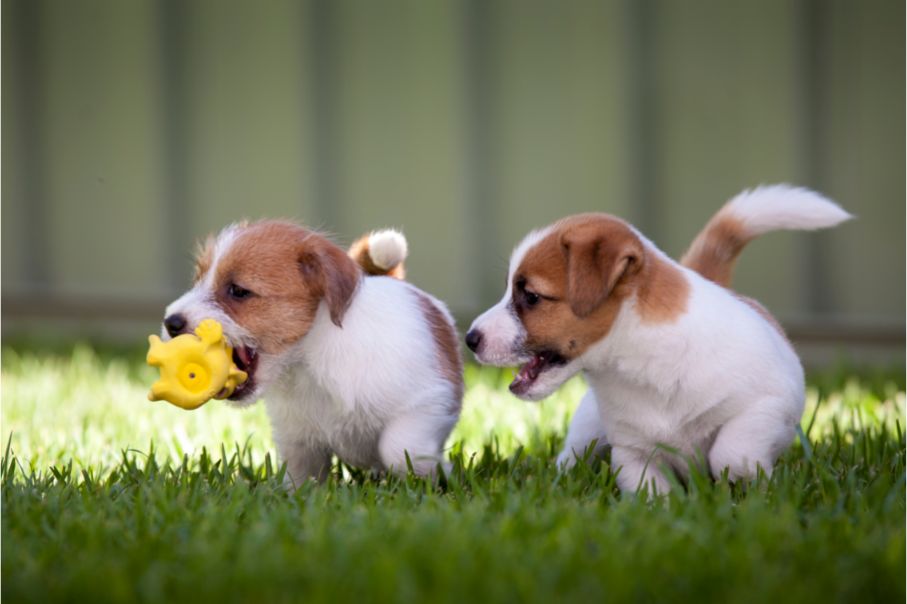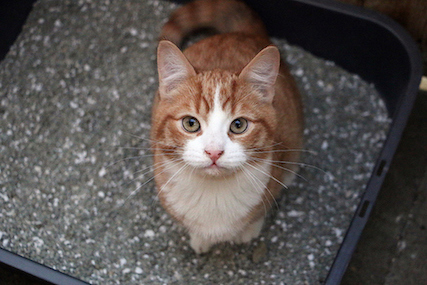In my practice I help clients navigate puppyhood and set puppies up to be lifelong family members. In doing so, I watch for early signs that might serve as red flags, often resulting in rehoming or euthanasia later in life. Together with loving owners, my trainers and I work to correct these behaviors early such that they don’t strengthen with age, creating more serious adult dog behavior. If you’re considering becoming a new puppy parent or have recently become one, read below to identify normal vs abnormal puppy behaviors. If you are concerned about your puppy’s behavior check out how to prevent those behaviors from developing into more serious problem behavior.
Playbiting: The Force of the Bite
Puppy playbiting is something nearly every puppy does. In fact, I can’t recall ever interacting with a young puppy who doesn’t playbite. It’s one of the few ways a puppy can communicate. Clients often report playbiting problematic around 10 weeks of age. While it can be painful and annoying even when typical, the degree of force that a puppy bites is what I pay attention to. When puppies bite it likely hurts, but should not result in drawing blood. If my clients have repeated scratches or punctures from their young puppy, it raises a red flag to me.
During the critical time of 3-8 weeks, puppies learn bite inhibition (i.e., how hard is too hard to bite) from their littermates. A play bite that occurs with enough pressure to break skin is generally a result of improper housing and lack of early socialization. This is a common red flag for puppies that are either raised in a puppy mill or removed from their littermates prior to the age of 8-9 weeks.
Abnormal playbiting is problematic because it can serve as an early indicator of more severe problem behaviors, including aggression. As your puppy ages, if he or she were to become aggressive at any point, they are more likely to result in a more severe bite. Dogs that lack bite inhibition are more likely to wound people, or dogs, if or when they bite. A small scuffle at a local dog park might be more likely to result in a fight resulting in an injured victim. An adult dog who snaps at a child might be more likely to wound the child. In addition to lacking bite inhibition, I have observed that these behaviors seem to be correlated with resource guarding later in life and biting as a result of restraint. Anecdotally, puppies who lack bite inhibition seem to engage in behaviors that are not as sensitive to punishment. In other words, problem behaviors aren’t easily reduced using punishment techniques. This can be challenging when it comes to correcting problem behaviors. In these cases, it is even more important to use positive reinforcement to reduce problem behaviors as they present themselves.

Restraint: Your Puppy’s Reaction to Mild Restraint
Another behavior that raises a red flag is an “abnormal” reaction to being restrained. Most puppies don’t simply melt into a handler’s lap if they are restrained in a way that is uncomfortable. Squirminess is normal! I normally look to see how quickly a puppy settles comfortably and how difficult a puppy is to restrain. I like to sit on the ground with my legs out straight in front of me. It’s important to note this is not an intimidation tactic or what some refer to as an alpha roll. I lay a puppy gently on their back and immediately begin feeding treats. With proper handling I expect a puppy to settle within 5-10 seconds. On rare occasions, a puppy will get agitated to the point of engaging in aggression, flipping their head around to bite aggressively. Agitation to the point of aggression and ignoring treats is an abnormal reaction to mild restraint.
Again, my concern lies in the fact that most of the time this behavior will worsen with age. These are cases that I see in my practice after they have bitten a veterinarian or groomer. The dog may have been picked up or restrained in a way that was uncomfortable for them. Instead of tolerating an uncomfortable level of restraint (which ideally doesn’t occur, but inevitably will in life), they learn early on that biting works. Unfortunately, if there is a point in which biting no longer works, dogs engage in even more intense levels of aggression which can result in even more significant biting.
If your puppy engages in this behavior, practice handling body parts while feeding your puppy. Hand feeding meals is a great way to ensure you are getting plenty of repetitions in. Gently grab your puppy’s ear or paw and feed a piece of dog food. Repeat 10-20 times on each side, covering as many body parts as possible. Practice approaching your puppy, picking them up, feeding them, and putting them back down. In the evenings sit on the floor and teach your puppy to settle as you feed them dinner. At your puppy’s veterinary appointment, be sure to feed small, tasty treats during scary times. Remember, these experiences should be positive. It’s your goal to teach your puppy that restraint results in good things!
Early Resource Guarding: Level of Interest in Edible Bones and Organic Matter
Most puppies have an interest in edible bones or have the propensity to pick up outdoor organic matter including leaves, acorns, and wood chips. These are typical behaviors and nothing out of the ordinary. Typical puppy behavior involves exploring the world with their mouth. I become concerned when puppies begin ingesting edible bones or items that may seem edible almost immediately upon contact, swallowing them whole. This behavior serves as a red flag, and I would label it abnormal. Regularly ingesting an entire item whole can be an early sign of resource guarding. Resource guarding normally worsens as dogs grow into adolescence and adulthood.
If your puppy does immediately ingest items, it’s important not to become too corrective when they do. In order to help manage your puppy’s behavior, have them always drag a leash. This helps to prevent some problem behavior before it occurs. Try to begin exchanging items with a treat. Although not the most effective method of preventing chewing in the future, this will create a more positive association with giving up items. The goal is that your puppy has a more positive experience by giving you the item. Puppies won’t stop picking things up, but they will give them up more easily. What’s more is that they will be less likely to develop resource guarding as they continue learning, which is the main priority.
Preventing Forceful Biting, Biting with Restraint, and Resource Guarding
All of the behaviors listed above can be prevented simply by ensuring your puppy has been housed with their litter mates with plenty of space to move around. How easy is that?! Puppies should continue living with their littermates through the age of 8-9 weeks. This is a critical time for puppies, and their siblings and mother are the best teachers! For more on what to look for in an environment in which your puppy is raised, check out my Bringing Puppy Home blog. If you already have your puppy, focus on using positive reinforcement to shape appropriate behavior and reduce problem behavior. For more information on how to use positive reinforcement in behavior modification, check out our blog.

Socialization: Time it Takes Puppies to “Recover” During Socialization
During your puppy’s socialization period, through puppyhood, and into adolescence it’s imperative to socialize your puppy. For more tips on how to properly socialize your puppy, check out my Bringing Puppy Home blog or our video on socializing your puppy. During that time your puppy will inevitably become fearful in some context. This behavior is completely typical as you help them learn about the world. If you deliver some upbeat praise and a few treats, your puppy should “recover” by investigating it a bit more or moving on with normal puppy behavior. I become a bit more concerned when it takes a puppy much longer to “recover” from the scary event.
These fear-related behaviors will likely strengthen as dogs get older. If they appear fearful of people or other animals, this avoidance often turns to aggression as puppies come into adulthood. In some extreme cases where puppies reach adolescence with little human involvement, dogs can appear “feral” and engage in what may seem like a lifetime of fear.
If your puppy is fearful and has a difficult time recovering from the scary event or is repeatedly fearful of something, it’s important to heavily and properly socialize your puppy. I recommend hiring an expert to help you and your puppy navigate the next month or so. For more information on who to hire, check out my When to Start, Who to Hire, and What Type of Program blog.
This behavior can be prevented by making sure your puppy was not only housed with their littermates, but also had good experiences with a variety of people, other animals, sights, smells, and sounds from 3-8 weeks. In addition to early socialization, I recommend meeting the parents and grandparents of your puppy whenever possible if purchasing your puppy. Parents and grandparents should be friendly with new people and dogs, approaching without hesitation or aggression. I recommend avoiding puppies with whom have parents or grandparents described as “good guardians,” “protective,” or “good with family members.” By ensuring your puppy was raised in a good environment and has friendly parents and grandparents, you are giving yourself and your puppy the best start to a lifetime of friendly behavior.
Potty Training: Normal Accidents vs Soiling the Crate
I recommend starting to potty train your puppy as soon as you get your puppy. Ideally it starts even before you get your puppy! During this process your puppy will inevitably have accidents. A few accidents are expected as your puppy learns where it is appropriate or inappropriate to potty. I become concerned when puppies begin or continue soiling their crate. The crate should be small enough and free of anything absorbent such that puppies are encouraged to keep it clean. It’s important to create a proper food and water schedule so puppies are set up for success. Be sure to have your puppy checked for a urinary tract infection and their stool examined for parasites. I become concerned when puppies soil the crate regularly with these proper steps in line.
If your puppy is in good health and free from infections or parasites, crate soiling is likely a result of a puppy living in a dirty environment. Most puppies that I treat for this problem behavior were housed in a puppy mill or pet store. Sadly, in these cases, puppies don’t have the freedom to play and eat away from where they are forced to soil. They begin losing an instinct of keeping their environment clean. To prevent this behavior from occurring, adopt or purchase a puppy who was raised inside a home and where the environment was properly kept clean. Ask to see where the puppies lived prior to committing to a puppy!
Crate Training: Crying in Crate vs Separation Anxiety
I often hear from my clients that their puppy has separation anxiety because they are crying when crated or when left alone. In most of these cases, puppies are engaging in what I would deem as normal behavior. Puppies don’t like to be alone! They have been living with their littermates and are quickly becoming attached to you. In some rare occurrences, puppies do engage in more severe behavior that I would describe as separation anxiety. Although this behavior normally develops around the age range of 3-5 years, in some extreme cases it is present during puppyhood and adolescence. Behaviors might include hours of crying in the crate, soiling the crate as a result of the stress of being alone, and self-injury. Self-injury comes in the form of bloody paws or mouths when puppies try to break out of the crate.
To prevent this behavior, prior to committing to your puppy, check to see if your puppy’s parents or grandparents engaged in this behavior. This is especially important if you are adopting or purchasing a puppy that is from a hunting line. It’s important that your puppy spends time alone from a young age and that the time alone is tied to something positive like mealtimes. If you already have your puppy and are experiencing what might feel like the start of separation anxiety, I recommend hiring a professional for an individualized treatment program targeting this behavior.
Using this guide, I’m hopeful you will be able to begin identifying whether your puppy’s behavior is normal or abnormal. If you’re concerned that their behavior is abnormal, early intervention using classical conditioning and positive reinforcement are key. These behaviors can be treated with the proper plan in place. With a proactive approach, you and your puppy will enjoy a lifetime of joy together.




